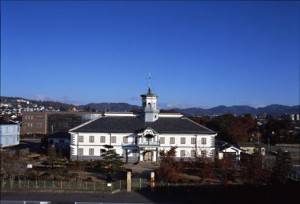About
FORMER KAICHI SCHOOL(National Treasure)

The Former Kaichi School Building, a National Treasure
The Former Kaichi School Building was one of the first public elementary schools in Japan. Built in 1876, the school’s design and architectural features exemplify the pseudo-Western style (giyōfū) that was popular in the 1870s. In 2019, the Former Kaichi School Building was the first modern-era school building to be designated a National Treasure.
The Origins of the Kaichi School
The Meiji Restoration in 1868 brought a wave of social and political changes that impacted every aspect of daily life, including education. After roughly 250 years of self-imposed isolation, the Japanese government abandoned its closed-borders policy and introduced a wide range of institutions and technologies from the West.
The Chikuma Prefectural School (precursor to the Kaichi School) first held classes in 1872. This first building was located on the grounds of a former Buddhist temple on the bank of the Metoba River. However, when national educational reform began and the prefectural school adopted a modern curriculum, the temple architecture seemed out of place in the culture of the time.
Tateishi Seijū (1829–1894), a Matsumoto-born master carpenter, was tasked with designing a new, Western-style school building. He made several trips to the relatively international cities of Tokyo and Yokohama to study the latest examples of Western architecture in Japan. Although Western-style buildings had begun to appear in these major cities, very little was known about Western architecture.
The giyōfū architectural style is a product of these late-nineteenth-century conditions: the style was created when carpenters like Tateishi, who had been trained in traditional woodworking techniques, imitated the designs of Western buildings. The resulting structures have a distinctive mix of Japanese and Western elements.
When the Former Kaichi School Building was constructed, its architecture was considered the cutting edge of design. Emperor Meiji (1852–1912) showed particular interest in the school when he visited Matsumoto in 1880, and photographs of the building were displayed at the world’s fairs in New Orleans (1884) and Chicago (1893).
From School to Museum
The Kaichi School opened to an enrollment of 1,051 students. Matsumoto’s local government ardently supported primary education, and this enthusiasm seems to have been shared by its residents. On average, only about one in every three Japanese children attended school in the 1870s, but at the Kaichi School, this ratio was close to two of every three.
Reading, writing, and arithmetic had been core skills for students even during the Edo period (1603–1867), when education mainly consisted of studying classical texts from China. The new, Meiji-era curriculum naturally included these subjects, but it emphasized the study of Western science and technology. The Kaichi School was also the only school in the prefecture that taught English Language and Culture (eigaku) as one of its core subjects.
The Kaichi School operated as an elementary school until 1963. Over those 84 years, the Metoba River flooded several times, damaging the school buildings. The main building was designated an Important Cultural Property in 1961, and this prompted the decision to relocate and restore it three years later. The Former Kaichi School Building is now a museum dedicated to the history of education in Japan. Its exhibits include textbooks and classroom equipment from the nineteenth century to the present.
※この英語解説文は観光庁の地域観光資源の多言語解説整備支援事業で作成しました。
This English language text was created by the Japan Tourism Agency.







